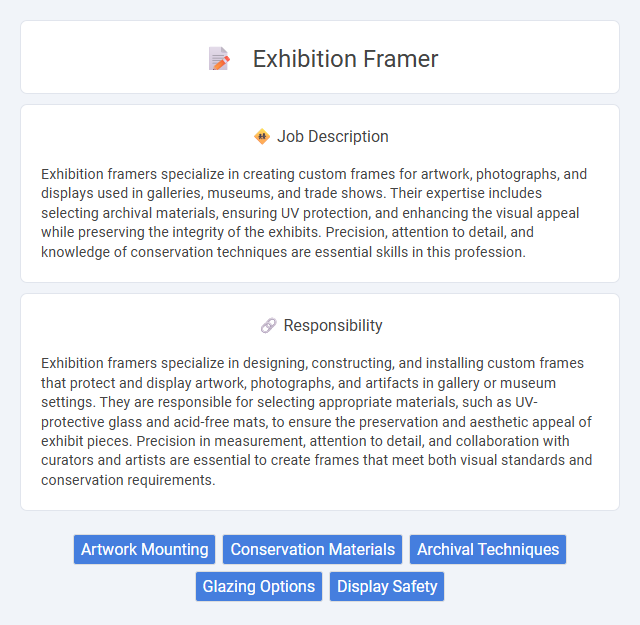
Exhibition framers specialize in creating custom frames for artwork, photographs, and displays used in galleries, museums, and trade shows. Their expertise includes selecting archival materials, ensuring UV protection, and enhancing the visual appeal while preserving the integrity of the exhibits. Precision, attention to detail, and knowledge of conservation techniques are essential skills in this profession.
Exhibition framer roles may suit individuals who possess strong attention to detail, steady hands, and a keen interest in art or design, as the job often involves precise measurements and delicate handling of materials. People who thrive in environments requiring patience and physical stamina might have a higher likelihood of success, though those prone to stress in fast-paced settings could find the demands challenging. Candidates with prior experience or enthusiasm for craftsmanship may have an increased probability of fitting well within this role.
Qualification
Exhibition framers require strong skills in precision cutting, mounting, and preservation techniques to ensure artwork and exhibits are displayed safely and attractively. Proficiency in various framing materials, glass types, and conservation-grade adhesives is essential to maintain the integrity of valuable pieces. A background in art handling, knowledge of museum standards, and certifications in framing or conservation significantly enhance a candidate's qualifications.
Responsibility
Exhibition framers specialize in designing, constructing, and installing custom frames that protect and display artwork, photographs, and artifacts in gallery or museum settings. They are responsible for selecting appropriate materials, such as UV-protective glass and acid-free mats, to ensure the preservation and aesthetic appeal of exhibit pieces. Precision in measurement, attention to detail, and collaboration with curators and artists are essential to create frames that meet both visual standards and conservation requirements.
Benefit
Exhibition framers likely enhance visual presentation, increasing artwork appeal and attracting visitor attention, which could boost gallery attendance and sales. They probably gain valuable experience with diverse materials and techniques, improving their craft and employability in the art or design industry. The role may offer flexible schedules and opportunities to collaborate with artists and curators, enriching professional networks and career growth.
Challenge
Exhibition framers likely face challenges in balancing artistic precision with durability, ensuring that delicate artworks are preserved while being visually appealing. The probability of encountering tight deadlines and customized framing requests may increase the demand for problem-solving skills and adaptability. Meeting client expectations while managing material constraints probably requires a high level of technical expertise and attention to detail.
Career Advancement
Exhibition framers specialize in crafting high-quality frames that preserve and enhance artwork or displays, positioning themselves as essential contributors within galleries and museums. Mastery of diverse framing techniques and materials can open pathways to supervisory roles, project management, or specialized conservation framing. Building a strong portfolio and industry connections accelerates career growth in the competitive arts and exhibition industry.
Key Terms
Artwork Mounting
Exhibition framers specialize in precise artwork mounting techniques to ensure the preservation and aesthetic presentation of valuable pieces. They utilize acid-free mats, UV-protective glazing, and custom supports tailored to different media, preventing damage and enhancing display quality. Expertise in secure hanging systems and climate-controlled environments safeguards artworks from environmental hazards during exhibitions.
Conservation Materials
Exhibition framers specializing in conservation materials utilize acid-free mats, UV-protective glass, and archival-quality adhesives to preserve artwork integrity during display. Expertise in selecting and handling these materials prevents deterioration caused by light exposure, humidity, and pollutants, ensuring long-term protection of valuable pieces. Their role combines technical skill with knowledge of preservation standards to maintain the artwork's authenticity and condition within exhibit environments.
Archival Techniques
Exhibition framers specializing in archival techniques ensure artworks and documents are preserved using acid-free mats, UV-protective glass, and stable mounting materials to prevent deterioration over time. They apply industry standards such as using buffered backings and humidity-control enclosures to maintain optimal conservation conditions. Expertise in archival framing enhances the longevity and visual integrity of valuable exhibitions in galleries and museums.
Glazing Options
Exhibition framers specialize in selecting premium glazing options such as UV-protective acrylic, museum-grade glass, and anti-reflective glass to safeguard artworks while enhancing visual clarity. These glazing materials provide varying levels of protection against light damage, glare reduction, and impact resistance, tailored to specific exhibition needs. Expert framers balance durability and aesthetics to preserve art integrity and optimize viewer experience.
Display Safety
Exhibition framers specialize in creating secure and durable display solutions to protect valuable artworks and exhibits from environmental hazards and physical damage. They use archival-quality materials and advanced mounting techniques to ensure long-term preservation and stability during transportation and installation. Their expertise in display safety is crucial for maintaining the integrity and visual appeal of exhibitions in galleries, museums, and public spaces.
 kuljobs.com
kuljobs.com